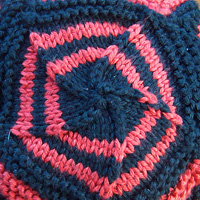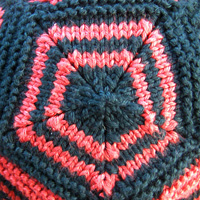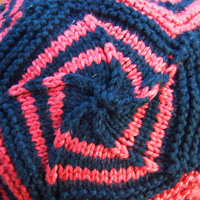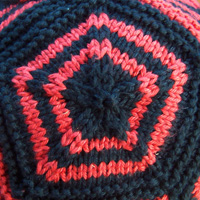
Pentagon
A |

Pentagon B |

Pentagon C
|

Pentagon D |

Pentagon E
|
FIRST HALF
First Pentagon:
Using MC, CO 80 sts. Join to begin working
in the round and work Pentagon A, using in
colors as follows:
Rounds 1-4: MC
Rounds 5-6: CC
Rounds 7-8: MC
Rounds 9-10: CC
Rounds 11-15: MC
Second Pentagon:
Using CC, CO 64 sts; continuing from these
sts, pick up and k 16 sts along one edge
of first pentagon. Join to begin working
in the round and work Pentagon B, working
colors as follows:
Rounds 1-4: CC
Rounds 5-6: MC
Rounds 7-8: CC
Rounds 9-10: MC
Rounds 11-15: CC
Third Pentagon:
Using CC, CO 48 sts; continuing from these
sts, pick up and k 32 sts along adjacent
edges of first and second pentagons (16 sts
from each pentagon).
Join to begin working
in the round and work Pentagon A, working
colors as for second pentagon.
Fourth Pentagon:
Using CC, CO 48 sts; continuing from these
sts, pick up and k 32 sts along adjacent
edges of first and third pentagons (16 sts
from each pentagon). Join to begin working
in the round and work Pentagon C, working
colors as for second pentagon.
Fifth Pentagon:
Using CC, CO 48 sts; continuing from these
sts, pick up and k 32 sts along adjacent
edges of first and fourth pentagons (16 sts
from each pentagon). Join to begin working
in the round and work Pentagon D, working
colors as for second pentagon.
Sixth Pentagon:
Using CC, CO 32 sts; continuing from these
sts, pick up and k 48 sts along adjacent
edges of second, first and fifth pentagons
(16 sts from each pentagon). Join to begin
working in the round and work Pentagon E,
working colors as for second pentagon. The
first half of the ball is complete.
Seventh Pentagon:
Using MC, CO 48 sts; continuing from these
sts, pick up and k 32 sts along adjacent
edges of two pentagons from the first half
of the ball (16 sts from each pentagon).
Join to begin working in the round and work
Pentagon A, working colors as for first pentagon.
Eighth Pentagon:
Using MC, CO 32 sts; continuing from these
sts, pick up and k 48 sts along adjacent
edges of seventh pentagon, and two pentagons
from the first half of the ball (16 sts from
each pentagon). Join to begin working in
the round and work Pentagon B, working colors
as for first pentagon.
Ninth Pentagon:
Using MC, CO 32 sts; continuing from these
sts, pick up and k 48 sts along adjacent
edges of eighth pentagon, and two pentagons
from the first half of the ball (16 sts from
each pentagon). Join to begin working in
the round and work Pentagon C, working colors
as for first pentagon.
Tenth Pentagon:
Using MC, CO 32 sts; continuing from these
sts, pick up and k 48 sts along adjacent
edges of ninth pentagon, and two pentagons
from the first half of the ball (16 sts from
each pentagon). Join to begin working in
the round and work Pentagon D, working colors
as for first pentagon.
Eleventh Pentagon:
Using MC, CO 16 sts; continuing from these
sts, pick up and k 64 sts along adjacent
edges of tenth pentagon, two pentagons from
the first half of the ball, and seventh pentagon
(16 sts from each pentagon). Join to begin
working in the round and work Pentagon E,
working colors as for first pentagon.
Before working last pentagon, turn ball inside
out and weave in all ends. Do so in such a
way that the fabric will not be distorted when
it is stretched by the stuffing.
Note: As written, ball is stuffed before last
pentagon is completed. If you are uncomfortable
working this way, cast on for one edge of the
last pentagon instead of picking up sts for
all edges, stuff the ball after knitting is
complete, then sew the opening closed.
Twelfth Pentagon:
Using CC, pick up and k 80 sts along edges
of seventh, eighth, ninth, tenth and eleventh
pentagons (16 sts from each pentagon). Join
to begin working in the round and work Pentagon
B, working colors as for second pentagon.
After working the first few rounds of this
pentagon, stuff the ball most of the way.
If adding noisemakers, do so at this point.
When pentagon is almost complete, finish
stuffing the ball. |

